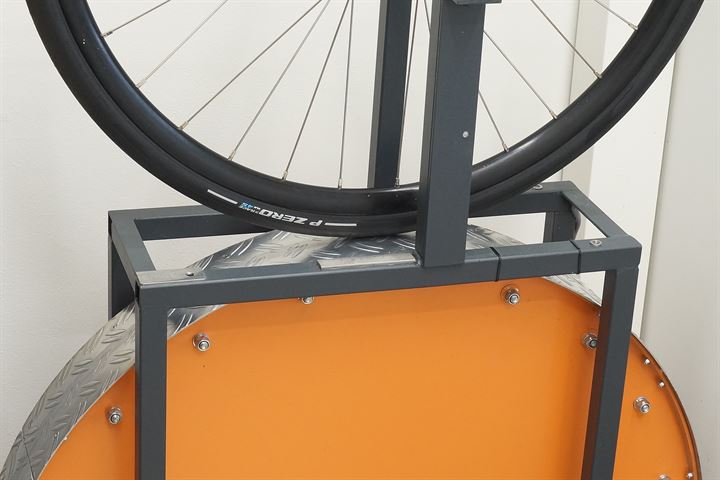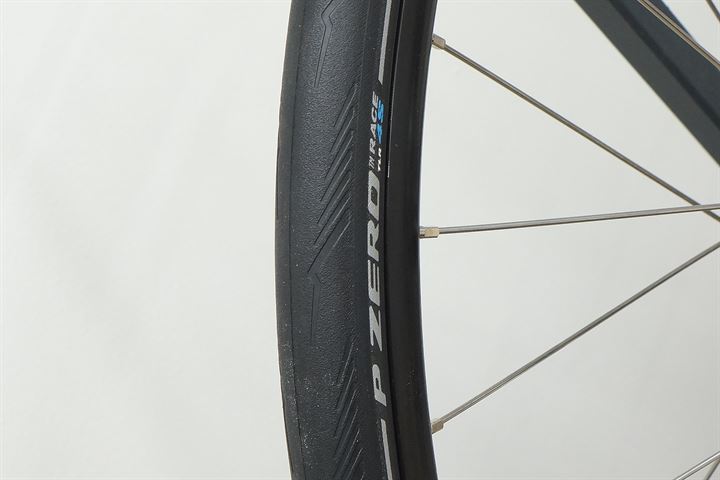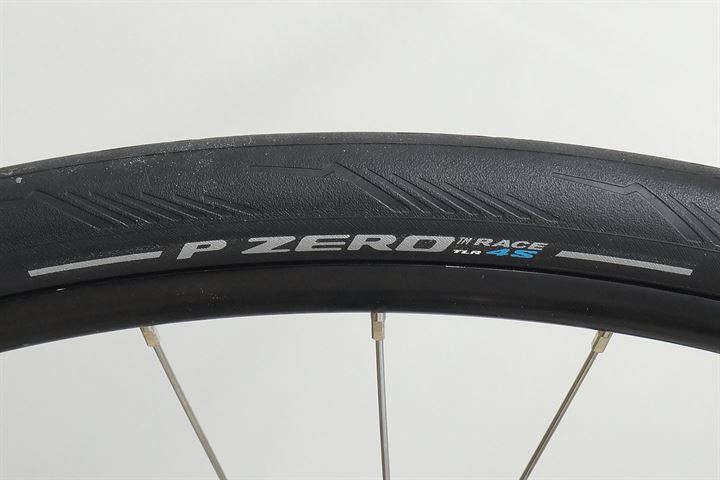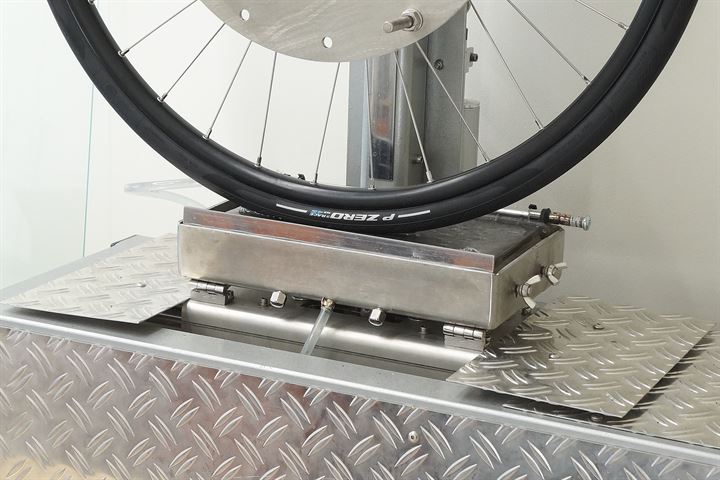Tire Lab Test: Pirelli P Zero Race TLR 4S SpeedCore 28
Contents and Test Summary
- Introduction
- Manufacturer Specifications
- Size, Weight, Thickness
- Rolling Resistance: 15.4 Watts
- Puncture Resistance: 64 Points
- Static Wet Grip: 76 Points
- Conclusion: 4.8 / 5 Highly Recommended
- Comments
- Pirelli P Zero Race TLR 4S SpeedCore 28
(100% is best)

Like the regular Pirelli P Zero Race TLR SpeedCore (read our review) we tested a few months back, the P Zero Race TLR 4S SpeedCore is made in Pirelli's new Italian factory. The 4S (4-Season) version of the P Zero Race TLR is closely related to the regular Race TLR, given both share the same casing construction. The 4S comes with increased puncture resistance and a different compound that Pirelli indicates as their best compound for wet grip and chemical grip.
From a specifications point of view, the only apparent differences between these tires are the compound, increased weight, and different tread pattern on the 4S version. When we look at the specified weights of the 28 mm sizes, we see the specified weight of the 4S comes in 35 grams heavier (330 grams) than the regular Race TLR, and it's a clear indication the 4S is not only made to be grippier but also offer better protection or durability.
We strongly suspect (with the help of our test results) that both the regular Race TLR and Race TLR 4S use the same exact casing design, with a possibility of the 4S using a slightly thicker or wider anti-puncture strip under the tread. We're not 100% sure about this, but Pirelli did something to increase the puncture resistance of the tread by roughly 15%, and it moves the P Zero Race TLR 4S up a class when it comes to puncture resistance.
While the regular Race TLR is available in a huge range of sizes ranging from 26 mm up to 40 mm, the 4S is available in just 3 sizes (28, 30, 32 mm). We've tested the 28 mm version, and we'll compare it against the regular 28 mm Race TLR Speedcore, the older 26 mm Pirelli Cinturato Velo TLR, and a bunch of other tires from competing brands.
Manufacturer Specifications
| Manufacturer Specifications | |
|---|---|
| Brand | Pirelli |
| Model | P Zero Race TLR 4S SpeedCore |
| Year | 2023 |
| Tire Type | Tubeless |
| Supplied By | Bought in store |
| New or Used | New |
| Mileage | 0 km |
| Price Range | Very High |
| Buy At | |
| Manufacturer part number | 4203500 |
| EAN | 8019227420357 |
| TPI | 120 |
| Compound | SmartNET Silica |
| Bead | Folding |
| ETRTO | 28-622 |
| Size Inch | 28" |
| Specified Width (mm) | 28 |
| Specified Weight | 330 grams |
| Max Air Pressure (psi) | 94 |
| Made In | Pro Data |
| Available Sizes |
28-622 (700x28c) 30-622 (700x30c) 32-622 (700x32c) |
Pirelli P Zero Race TLR 4S SpeedCore 28 Test Results

Size, Weight, and Thickness Measurements
| Size, Weight and Thickness Measurements | |
|---|---|
| Specified Weight | 330 grams |
| Measured Weight | 330 grams |
| System Adjusted Weight (tire + valve + rim seal) |
350 grams |
| Measured Width | 28 mm (un-round) |
| Measured Height | Pro Data |
| Tire Circumference | Pro Data |
| Total Tire Thickness Center | 3.1 mm |
| Total Tire Thickness Sidewall | Pro Data |
| Unmounted Casing Width | 70 mm |
| Unmounted Tread Width | Pro Data |
| Tread Cover (Tread / Casing Ratio) | Pro Data |
| All size measurements are taken at an air pressure of 100 psi / 6.9 bars on a 17.8 mm inner width rim. | |
Rolling Resistance Test Results
| Rolling Resistance Test Results | |
|---|---|
| Inner Tube | None (20 ml sealant) |
| Measured Width | 28 mm (un-round) |
| Rolling Resistance Real tire width in mm: 22-24 = 132 psi/9.1 bar 25-27 = 120 psi/8.3 bar 28-30 = 108 psi/7.4 bar 31-32 = 100 psi/6.9 barUltra High Air Pressure (108 psi / 7.4 bar) |
Pro Data |
| Rolling Resistance Real tire width in mm: 22-24 = 110 psi/7.6bar 25-27 = 100 psi/6.9 bar 28-30 = 90 psi/6.2 bar 31-32 = 83 psi/5.7 barExtra High Air Pressure (90 psi / 6.2 bar) |
Pro Data |
| Rolling Resistance Real tire width in mm: 22-24 = 88 psi/6.1 bar 25-27 = 80 psi/5.5 bar 28-30 = 72 psi/5.0 bar 31-32 = 67 psi/4.6 barHigh Air Pressure (72 psi /5.0 bar) |
15.4 Watts CRR: 0.00462 |
| Rolling Resistance Real tire width in mm: 22-24 = 66 psi/4.6 bar 25-27 = 54 psi/4.1 bar 28-30 = 60 psi/3.7 bar 31-32 = 50 psi/3.4 barMedium Air Pressure (54 psi / 3.7 bar) |
Pro Data |
| The Road Bike section is a multi tire size section, air pressures have been adjusted to the measured casing width. All numbers are for a single tire at a speed of 29 km/h / 18 mph and a load of 42.5 kg / 94 lbs. Use the formula: RR (Watts) = CRR * speed (m/s) * load (N) to calculate rolling resistance at a given speed and load. |
|
Puncture Resistance Test Results

| Puncture Resistance Test Results (higher is better) | |
|---|---|
| Total Puncture Score Tread | 64 Points |
| Total Puncture Score Sidewall | Pro Data |
| Tread Puncture Force Sharp Needle | Pro Data |
| Tread Puncture Force Blunt Needle | Pro Data |
| Tread Total Tire Thickness | 3.1 mm |
| Sidewall Puncture Force Sharp Needle | Pro Data |
| Sidewall Puncture Force Blunt Needle | Pro Data |
| Sidewall Total Tire Thickness | Pro Data |
Static Grip Test Results

| Static Grip Test Results | |
|---|---|
| Wet Grip Average | 76 Points |
| Wet Grip Center | Pro Data |
| Wet Grip Edge | Pro Data |
| Grip in points = coefficient of friction * 100 Road bike grip test rim width = 19.0 mm |
|
Conclusion
- Pirelli P Zero Race TLR 4S SpeedCore 28
(100% is best)
The Pirelli P Zero Race TLR 4S is a very strong performer, but it misses that last edge in our tests to deserve a 5 out of 5 rating. Compared to the regular Race TLR SpeedCore (read our review), the 4S offers 15% better puncture resistance, but it comes at the cost of a 15% increase in rolling resistance. The wet grip is extremely strong on the 4S, but it's only a marginal gain over the regular Race TLR, which already offers best-in-class wet grip.
We suspect the compound found on the 4S version is grippier, but the changes required to increase puncture resistance make the tire less flexible. Grip on a bicycle tire is a combination of the flexibility of the casing and grip of the compound. When you strengthen the casing to increase puncture resistance, you need a grippier compound to achieve the same overall grip levels.
A complication with testing 4-season tires is that they might be optimized more for winter temperatures. We test tires at a temperature between 21.5-22.5 °C / 70-73 °F, which we think is a good temperature to get an overall picture of the performance of bicycle tires. When you're specifically looking for a winter tire, we recommend picking the 4S or all-season tire from a given manufacturer when our tests indicate performance is too close to call.
RATING:
4.8
/ 5
TEST VERDICT:
Highly Recommended
